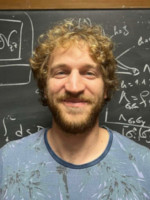Research Interests:
Quantum Computation; Decoherence in quantum devices; Quantum error mitigation
Journal Articles
2024
Figurato, Laria; Dirindin, Marco; Gaona-Reyes, José Luis; Carlesso, Matteo; Bassi, Angelo; Donadi, Sandro
On the effectiveness of the collapse in the Diósi–Penrose model Journal Article
In: New J. Phys., vol. 26, no. 11, 2024, ISSN: 1367-2630.
@article{Figurato2024b,
title = {On the effectiveness of the collapse in the Diósi–Penrose model},
author = {Laria Figurato and Marco Dirindin and José Luis Gaona-Reyes and Matteo Carlesso and Angelo Bassi and Sandro Donadi},
doi = {10.1088/1367-2630/ad8c77},
issn = {1367-2630},
year = {2024},
date = {2024-11-01},
journal = {New J. Phys.},
volume = {26},
number = {11},
publisher = {IOP Publishing},
abstract = {Abstract
The possibility that gravity plays a role in the collapse of the quantum wave function has been considered in the literature, and it is of relevance not only because it would provide a solution to the measurement problem in quantum theory, but also because it would give a new and unexpected twist to the search for a unified theory of quantum and gravitational phenomena, possibly overcoming the current impasse. The Diósi–Penrose model is the most popular incarnation of this idea. It predicts a progressive breakdown of quantum superpositions when the mass of the system increases; as such, it is susceptible to experimental verification. Current experiments set a lower bound
R
0
≳
4
R
0
≲
10
6
},
keywords = {},
pubstate = {published},
tppubtype = {article}
}
Gaona-Reyes, José Luis; Menéndez-Pidal, Lucía; Faizal, Mir; Carlesso, Matteo
Spontaneous collapse models lead to the emergence of classicality of the Universe Journal Article
In: J. High Energ. Phys., vol. 2024, no. 2, 2024, ISSN: 1029-8479.
@article{Gaona-Reyes2024,
title = {Spontaneous collapse models lead to the emergence of classicality of the Universe},
author = {José Luis Gaona-Reyes and Lucía Menéndez-Pidal and Mir Faizal and Matteo Carlesso},
doi = {10.1007/jhep02(2024)193},
issn = {1029-8479},
year = {2024},
date = {2024-02-00},
journal = {J. High Energ. Phys.},
volume = {2024},
number = {2},
publisher = {Springer Science and Business Media LLC},
abstract = {Abstract
Assuming that Quantum Mechanics is universal and that it can be applied over all scales, then the Universe is allowed to be in a quantum superposition of states, where each of them can correspond to a different space-time geometry. How can one then describe the emergence of the classical, well-defined geometry that we observe? Considering that the decoherence-driven quantum-to-classical transition relies on external physical entities, this process cannot account for the emergence of the classical behaviour of the Universe. Here, we show how models of spontaneous collapse of the wavefunction can offer a viable mechanism for explaining such an emergence. We apply it to a simple General Relativity dynamical model for gravity and a perfect fluid. We show that, by starting from a general quantum superposition of different geometries, the collapse dynamics leads to a single geometry, thus providing a possible mechanism for the quantum-to-classical transition of the Universe. Similarly, when applying our dynamics to the physically-equivalent Parametrised Unimodular gravity model, we obtain a collapse on the basis of the cosmological constant, where eventually one precise value is selected, thus providing also a viable explanation for the cosmological constant problem. Our formalism can be easily applied to other quantum cosmological models where we can choose a well-defined clock variable. },
keywords = {},
pubstate = {published},
tppubtype = {article}
}
2021
Gundhi, A.; Gaona-Reyes, J. L.; Carlesso, Matteo; Bassi, A.
Impact of Dynamical Collapse Models on Inflationary Cosmology Journal Article
In: Phys. Rev. Lett., vol. 127, no. 9, 2021, ISSN: 1079-7114.
@article{Gundhi2021c,
title = {Impact of Dynamical Collapse Models on Inflationary Cosmology},
author = {A. Gundhi and J. L. Gaona-Reyes and Matteo Carlesso and A. Bassi},
doi = {10.1103/physrevlett.127.091302},
issn = {1079-7114},
year = {2021},
date = {2021-08-00},
urldate = {2021-08-00},
journal = {Phys. Rev. Lett.},
volume = {127},
number = {9},
publisher = {American Physical Society (APS)},
keywords = {},
pubstate = {published},
tppubtype = {article}
}
Gaona-Reyes, J. L.; Carlesso, Matteo; Bassi, A.
Gravitational interaction through a feedback mechanism Journal Article
In: Phys. Rev. D, vol. 103, no. 5, 2021, ISSN: 2470-0029.
@article{Gaona-Reyes2021,
title = {Gravitational interaction through a feedback mechanism},
author = {J. L. Gaona-Reyes and Matteo Carlesso and A. Bassi},
doi = {10.1103/physrevd.103.056011},
issn = {2470-0029},
year = {2021},
date = {2021-03-00},
urldate = {2021-03-00},
journal = {Phys. Rev. D},
volume = {103},
number = {5},
publisher = {American Physical Society (APS)},
keywords = {},
pubstate = {published},
tppubtype = {article}
}

Biography
Graduated in Physics at the University of Trieste (2019). He is currently a PhD student at the university of Trieste